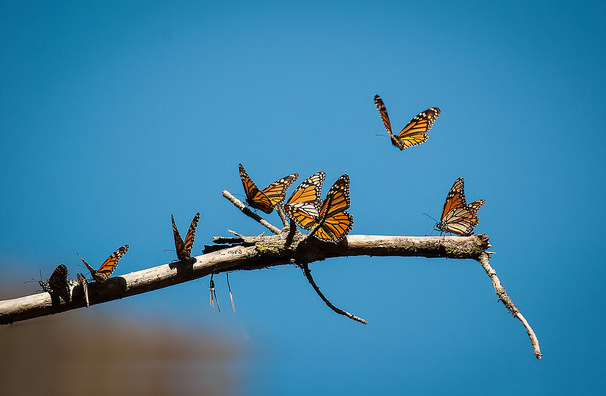Like this article? rabble is reader-supported journalism. Chip in to keep stories like these coming.
As described in the film Flight of the Butterflies, University of Toronto scientist Fred Urquhart and his wife Norah patiently studied the migration of the monarch butterfly for decades, searching for its winter home. They engaged hundreds of citizen scientists in placing tiny tags on butterflies in late summer just before migration. Recoveries of tagged butterflies eventually helped locate the monarchs’ remote, fir-covered mass roosting sites in Mexico’s Sierra Madre mountain range in 1975.
In January 1976, when Fred and Norah visited the site, a branch heavily laden with butterflies crashed down at Fred’s feet. Amazingly, he almost immediately found a monarch that had been tagged and released by two Minnesota schoolboys a few months earlier. This provided conclusive proof that this remarkable individual butterfly had completed a long-distance flight to central Mexico.
Monarch butterflies feature prominently on the logo of the Commission for Environmental Cooperation, the tri-national organization through which the governments of Canada, Mexico and the United States collaborate on environmental protection and conservation. Unfortunately, major declines in monarch populations in recent years are signalled by shrinking forest areas occupied by roosting butterflies in winter. These declines have made the species one of North America’s highest conservation priorities.
A new study published in the journal Scientific Reports on March 21, 2016 concludes that the eastern migratory population of monarchs “has a substantial probability of quasi-extinction” during the next 20 years, with quasi-extinction defined as “loss of a viable migratory population of monarchs in eastern North America.” Smaller numbers of monarchs might persist west of the Rockies, but loss of the eastern population would eliminate over 90 per cent of the Canadian distribution of this species.
Logging and climate change constitute threats to wintering monarchs, but loss of summer habitat — particularly owing to agricultural intensification — is the primary cause of population declines. Adult female monarchs lay their eggs on native milkweeds, which then provide food for caterpillars. As explained by the authors of the new study: “Declines in milkweed abundance are well documented and highly correlated with the adoption of herbicide-tolerant genetically modified corn and soybeans, which now constitute 89 per cent and 94 per cent of these crops, respectively, in the U.S.”
To quantify how increased herbicide use is impacting monarchs, the authors of the new study drew upon an earlier 2012 paper, “Milkweed loss in agricultural fields because of herbicide use: effect on the Monarch butterfly population.” Authors of the new study concluded that loss of milkweeds, combined with risks of mass mortality while overwintering in Mexico, creates a significant probability of monarch extinction. They also considered additional threats in the species’ summer range: “[i]nsecticides (including neonicotinoids and others), mowing regimes, invasive species, and disease incidence.”
Butterfly conservation efforts
Their findings likely come as no surprise to scientists who study how changing land management practices affect butterflies and other native insects. Iowa State University professor Diane Debinski recently addressed a well-attended webinar entitled “Landscapes for Butterfly Conservation.” Her research focuses on the corn belt of the U.S. Midwest: ground zero for monarch conservation efforts.
One study by Dr. Debinski and her students shows that riparian buffer strips in farming areas can benefit butterflies — particularly if buffer strips include native forbs (flowering plants other than grasses). While “even narrow filter strips were used by butterflies… wider plantings support a higher diversity of butterflies, as well as larger abundances of habitat-sensitive butterflies.” The researchers acknowledged that conservation comes with a cost, but recommend “enhancing filter strips by the use of wider plantings… and forbs… whenever financially possible.” During the webinar, Dr. Debinski noted that monarchs in particular respond to wider buffer strips.
Debinski’s research has also shown benefits of reduced roadside mowing, wider roadside buffers, and rotation of pastures in grazing operations. Unlike monarchs, most butterflies are non-migratory; leaving more dead vegetation on the ground increases winter survival of eggs and caterpillars.
According to Debinski, the gold standard for butterfly conservation is preservation and restoration of native prairies. In Canada, just as in the U.S., tall-grass prairie has been reduced to a tiny fraction of its original extent. Healthy prairies require both grazing and periodic fire: not too much, but not too little. Maintaining this balance was not an issue when native prairies covered 90 per cent of the landscape, as in Iowa, but is now a matter of active human intervention. Mowing can substitute for grazing to some extent. Powerline corridors can be good candidates for butterfly habitat restoration.
Although Dr. Debinski’s presentation focused on making rural landscapes better places for butterflies, many participants asked questions about urban habitats. She noted that while caterpillars rely on specific food plants, adult butterflies feed on nectar from a variety of sources. Urban gardens provide good nectar resources and are generally free of the pesticides found in crop fields.
As is the case for many of our best-loved species, preventing monarch extinction will require active intervention by humans on a variety of fronts. Actions that benefit monarchs will also increase the abundance and diversity of a full range of native butterflies. This provides a challenge and an opportunity for those of us who believe that abundant nature enhances the quality of our lives.
Ole Hendrickson is a retired forest ecologist and a founding member of the Ottawa River Institute, a non-profit charitable organization based in the Ottawa Valley.
Photo: Anita Ritenour/flickr
Like this article? rabble is reader-supported journalism. Chip in to keep stories like these coming.



